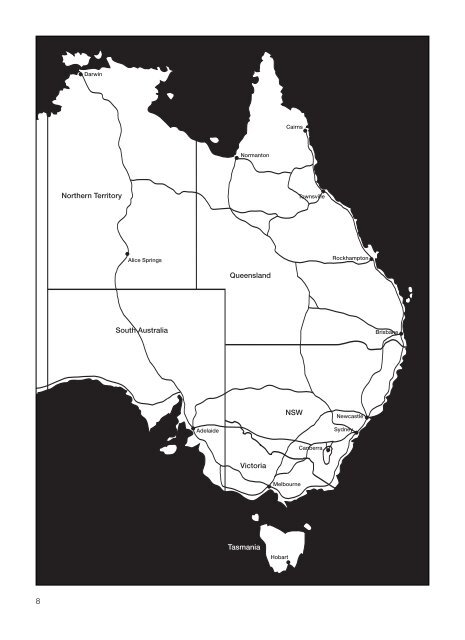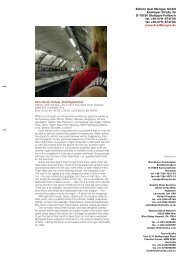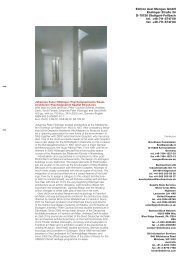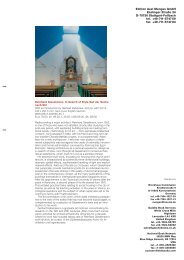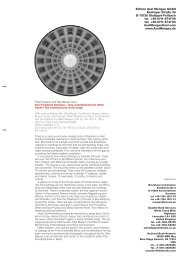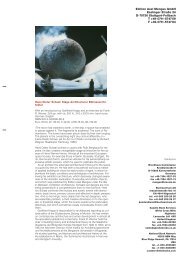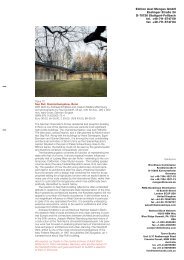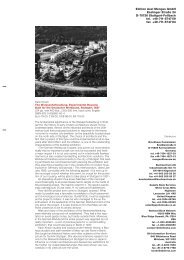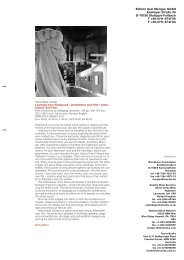The Architecture of East Australia - Edition Axel Menges
The Architecture of East Australia - Edition Axel Menges
The Architecture of East Australia - Edition Axel Menges
You also want an ePaper? Increase the reach of your titles
YUMPU automatically turns print PDFs into web optimized ePapers that Google loves.
8<br />
Darwin<br />
Northern Territory<br />
Alice Springs<br />
South <strong>Australia</strong><br />
Adelaide<br />
Normanton<br />
Queensland<br />
Victoria<br />
Tasmania<br />
Cairns<br />
Melbourne<br />
Hobart<br />
NSW<br />
Townsville<br />
Canberra<br />
Rockhampton<br />
Newcastle<br />
Sydney<br />
Brisbane<br />
<strong>The</strong> architecture <strong>of</strong> <strong>East</strong> <strong>Australia</strong><br />
»<strong>The</strong> future was dark and the past was dead<br />
As they gazed on the sea once more<br />
But a nation was born when the immigrants said<br />
Good-bye! as they stepped ashore!<br />
In their loneliness they were parted thus<br />
Because <strong>of</strong> the work to do,<br />
A wild wide land to be won for us<br />
By hearts and hands so few.<br />
<strong>The</strong> darkest land ’neath a blue sky’s dome,<br />
And the widest waste on earth;<br />
<strong>The</strong> strangest scenes and the least like home<br />
In the lands <strong>of</strong> our fathers’ birth;<br />
<strong>The</strong> loneliest land in the wide world then,<br />
And away on the furthest seas,<br />
A land most barren <strong>of</strong> life for men<br />
And they won it by twos and threes!«<br />
Excerpt from How <strong>The</strong> Land Was Won<br />
by Henry Lawson (1867–1922)<br />
<strong>The</strong> story <strong>of</strong> <strong>Australia</strong>n architecture is the story <strong>of</strong> the<br />
European expansion into and gradual possession <strong>of</strong><br />
the <strong>Australia</strong>n landscape. <strong>The</strong> story commences with<br />
European settlers who held the firm conviction that<br />
<strong>Australia</strong> was terra nullius, empty place. <strong>The</strong>ir story is<br />
<strong>of</strong> migration, taking possession <strong>of</strong> and making do in a<br />
new land. <strong>The</strong> continent’s original people could tell an<br />
alternative story, a story only recently listened to by architects,<br />
but it is not the story <strong>of</strong> this book.<br />
<strong>The</strong> architecture <strong>of</strong> these recent arrivals is the story<br />
<strong>of</strong> the individuals with an ambition to make a new<br />
place in the world. <strong>The</strong> buildings they left are the trace<br />
that tells the story <strong>of</strong> their successes and sometimes<br />
their deprivations. It almost always speaks <strong>of</strong> their aspirations.<br />
<strong>The</strong> European settlement <strong>of</strong> <strong>Australia</strong> commenced<br />
with the arrival <strong>of</strong> the first fleet in 1788. This was during<br />
the great period <strong>of</strong> European expansion that on one<br />
hand brought Christianity and European culture to the<br />
world and on the other opened up new commercial<br />
opportunities to the Europeans. As the British plied<br />
their ships across open oceans looking for new lands<br />
so they crossed the open plains <strong>of</strong> the continent <strong>of</strong><br />
<strong>Australia</strong> on foot, horseback and bullock dray. Little<br />
thought did they give to the rights <strong>of</strong> the indigenous<br />
population as they pushed out along the shores <strong>of</strong> the<br />
continent and then into the mainland. <strong>The</strong>ir fortune lay<br />
the way <strong>of</strong> accumulating farmlands and opening up<br />
trade routes.<br />
Long would they toil to make the landscape economically<br />
productive.<br />
Yet the first fleet were merely the first <strong>of</strong> successive<br />
waves <strong>of</strong> migrants who continue to this day to arrive at<br />
<strong>Australia</strong>n ports. Like the first settlers today’s migrants<br />
share a similar burden <strong>of</strong> having to make a place for<br />
themselves in a new world.<br />
A central theme <strong>of</strong> <strong>Australia</strong>n architecture is this<br />
making do or vigorous adaptation <strong>of</strong> old ideas to new<br />
settings. Migrants to <strong>Australia</strong>, up until the 1970s,<br />
came mainly from Europe or were <strong>of</strong> a European origin.<br />
<strong>The</strong> ideas on which <strong>Australia</strong>n architecture is based<br />
are still largely <strong>of</strong> a European or American basis.<br />
While not every good <strong>Australia</strong>n architect was born<br />
or studied elsewhere it is evident through a brief survey<br />
<strong>of</strong> the history <strong>of</strong> <strong>Australia</strong>n architecture that, so far at<br />
least, the main events that make up the story <strong>of</strong> <strong>Australia</strong>n<br />
architecture can be told by reference solely to<br />
architects born elsewhere.<br />
<strong>Australia</strong> has been graced by the arrival <strong>of</strong> young architects<br />
from Francis Greenway through to Harry Seidler.<br />
Architects trained overseas have come to <strong>Australia</strong><br />
to do their best work. <strong>The</strong>se have included William<br />
Wardell, who built St Patrick’s Cathedral (M6) in Melbourne<br />
and St Mary’s Cathedral (S38) in Sydney. Joseph<br />
Reed who designed the State Library <strong>of</strong> Victoria<br />
(M2) came from Cornwall. Leonard Terry who designed<br />
the Melbourne Club (M5) came from Yorkshire. John<br />
Verge, who brought the Regency style to <strong>Australia</strong> was<br />
from Hampshire, England while James Barnet who designed<br />
the General Post Office (S47) in Macquarie<br />
Street, Sydney, was born in Scotland. John Horbury<br />
Hunt came to <strong>Australia</strong> from Canada via Boston; Walter<br />
Liberty Vernon who built the State Library <strong>of</strong> New<br />
South Wales (S56) and Sir John Sulman who had great<br />
influence upon the planning <strong>of</strong> Canberra were both<br />
English and worked in London before coming to <strong>Australia</strong>.<br />
Later in the 20th century architects who migrated<br />
to <strong>Australia</strong> included Leslie Wilkinson from Britain,<br />
Walter Burley Griffin from the United States <strong>of</strong><br />
America, Frederick Romberg, who was born in Tsingtao,<br />
China and educated in Switzerland, Harry Seidler,<br />
born in Austria and educated in Canada and the United<br />
States and Alex Popov, born in China. Visitors to<br />
<strong>Australia</strong> would include Jørn Utzon and recently Renzo<br />
Piano. Even Glenn Murcutt speaks <strong>of</strong> the importance<br />
<strong>of</strong> his very early years spent in New Guinea.<br />
A feature <strong>of</strong> these architects is that many moved<br />
around the continent rather than settling in one place<br />
all their lives. People like Wardell, Hunt, Griffin and<br />
Romberg built in many disparate locations. It would<br />
seem that the energy that brought them to <strong>Australia</strong><br />
kept propelling them around the country after they arrived.<br />
<strong>The</strong> 20th century being the great age <strong>of</strong> travel,<br />
many local born young architects did their first degrees<br />
in <strong>Australia</strong> and then travelled overseas to undertake<br />
postgraduate studies and spent some years practising<br />
overseas (a practice which is still very popular in <strong>Australia</strong><br />
and carries great weight among the pr<strong>of</strong>ession).<br />
Peter Muller, Lawrence Nield and Bruce Rickard in<br />
Sydney would be included in this group.<br />
Even today, architects such as Glenn Murcutt adapt<br />
ideas and devices from international sources. Murcutt<br />
has been very clear about the inspiration he has gained<br />
from trips to Greece and Africa and has been specific<br />
9


